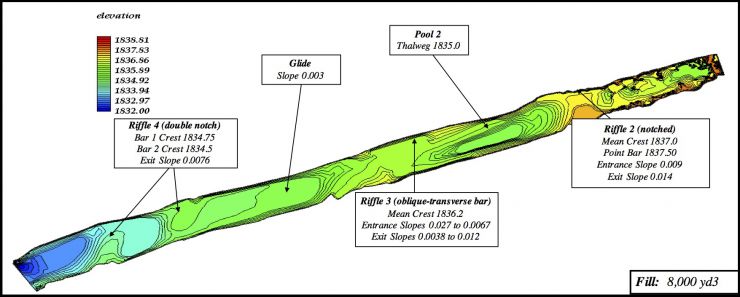TR Design 4
Concept
Design 4 was the first of three blanket fills with riffle-pool reliefs lower than the initial degraded state of the baseline reach. The riffle-pool amplitude was 0.58, which was 26% less than the pre-project amplitude and the lowest value tested. Riffle-pool asymmetry however, did increase from pre-project conditions from 0.99 to 3.01. This value is so large, because the third pool-to-riffle unit in Design Four had a pool trough that was above the zero-crossing line with a very small de-trended elevation. That yielded an A*RP value of 6.9 for that unit, whereas the upper two units had substantially lower values of 0.98 and 1.13. Thus, even though the amplitude is very low, the fact that the bed undulation occurs on top of fill creates a strong asymmetry for the last pool-to-riffle unit. This design sought to increase fluvial complexity, while maintaining low feature-to-feature slopes. A new feature for this design that was also used in Designs Five and Six was that the channel was widened 3 m on river right to remove encroached vegetation and provide low-velocity, shallow habitat for fry. The upstream riffle was widened, but features a bar crest on river left. The subsequent pool was elongated, narrowed, and filled in somewhat. The next riffle was an oblique transverse crest, somewhat similar to the one in the middle of Design One, but wider. It had a bar on river left to serve as a gravel supply during high flows and to force the flow direction to go over shallow portions of the riffle on river right to increase steelhead spawning and rearing habitat there. The biggest difference from the earlier designs was that after that riffle, the channel was given a long glide that gradually slopes into the next riffle, which featured a pair of tightly-spaced alternating bars. Glides can serve for salmon spawning, especially for steelhead, so it was a worthwhile landform to evaluate. It was predicted that this last complex oblique transverse riffle would cause flow divergence into the riffle and then convergence on river right after it. Depending on riffle height and discharge, it was thought that an eddy might form downstream of the riffle on the left. This feature tracks existing contours and mimics a feature that was present in 1944, as shown in an aerial photograph. The oblique orientation of the riffle also had the benefit of extending the mean riffle width, causing flow fields from the preceding pool to diverge and cause deposition. Moreover, these divergent flow patterns were predicted to promote autumn low spawning-flow riffle stability. Another benefit to using an oblique transverse riffle was thought to be that entrance and exit slopes vary laterally. For this feature, entrance slopes varied from the river right at 2.7% to the river left at 0.67%. Exit slopes from the river right at 0.38% to the river left at 1.2%. These values indicate different longitudinal riffle-crest asymmetries across the channel, which is a design elements that cannot be evaluated using a 1D model. The final riffle exit was narrowed on river left, with a horseshoe convergence on river right. This use of variable depth on river left was thought to provide rearing habitat on river left. Design Four was estimated to need 6,116 m3 of gravel and cobble.
Design Map

Design Hypotheses
| Attributes | Riffle 2 | Pool 2 | Riffle 3 |
| Hydraulic | Existing riffle widened to promote flow divergence. Preceding pool exit slope graded to gradually dissipate high velocities. |
Constricted pool will induce flow convergence, flow acceleration, and eddy formation adjacent to banks. |
Oblique-transverse riffle will cause flow divergence over riffle and then convergence on right after riffle. Depending on riffle height, an eddy may form downstream of the riffle on left. |
| Geomorphic | Flow divergence will minimize scour from pool exit to riffle crest. Gravel supply on river right to be mobilized at high flows and deposited downstream. |
Pool uses existing contour regime. Scour in pool and sediment deposition along periphery in eddies will promote pool self-maintenance. |
Transverse riffle tracks existing contours. Crest length extended by oblique orientation. Divergent flow promotes spawning-flow riffle stability. |
| Fisheries | -Spawning on riffle crest and pool exit slope. -Increased fry habitat along channel margins. |
-Adult holding habitat in pool. -Fry habitat along channel margins. -Spawning on peripheral pool benches. |
-Spawning habitat on riffle. Pool-exit rim shape promotes gravel oxygenation and provides good habitat. -Increased fry habitat along channel margins. |
| Attributes | Glide | Riffle 4 |
| Hydraulic | Gradually sloped riffle exit slope. Existing channel widened to minimize flow convergence from preceding riffle. |
Notched transverse bars yield desired velocity over riffle crests. Alternating flow paths around point bars for heterogeneity. Slow eddy formation on downstream bar faces along banks. |
| Geomorphic | Flow convergence at the head of glide and divergence will occur as water moves downstream through feature. |
Notches may self-enhance over time. |
| Fisheries | -Large spawning region on glide. -Juvenile rearing on glide. |
Spawning on all of riffle. -Increased fry habitat along channel margin. -Juvenile and adult habitat in notches. |
Design Testing with FESWMS 2D Model
System response was evaluated in terms of flow pattern, fish habitat quality, and sediment transport regime at three discharges within the regulated range permitted by operational rules at the time. At the links below, the results are shown for two of those discharges: (1) a typical baseflow (300 cfs) present during most of the year when fish are spawning and embryos are incubating and (2) the peak regulated flood discharge released by the dam at that time (6000 cfs).
Click links below to see model results:


